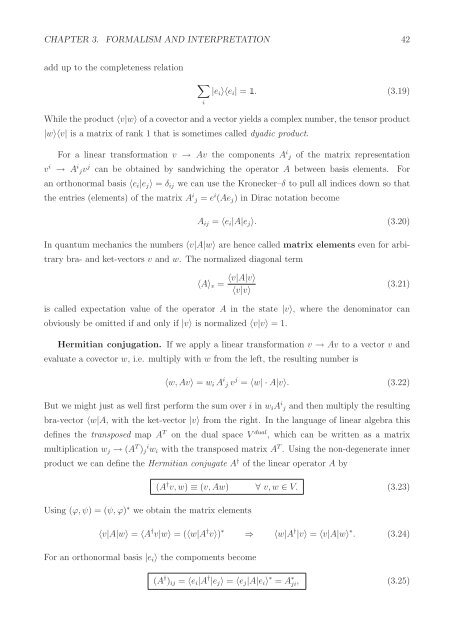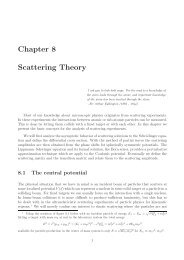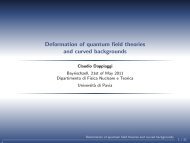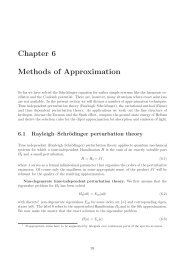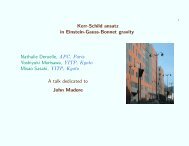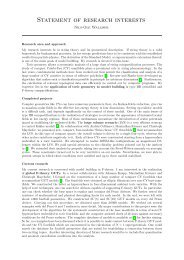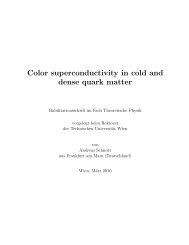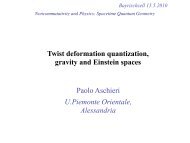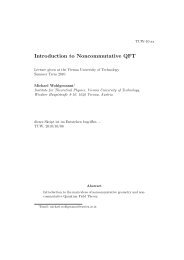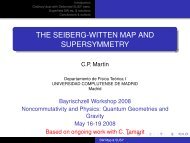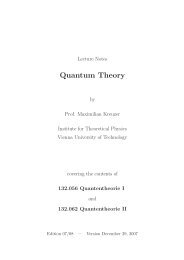- Page 7 and 8: Chapter 1Introduction1.1 Historical
- Page 9: CHAPTER 1. INTRODUCTION 3Physicists
- Page 13 and 14: CHAPTER 1. INTRODUCTION 7it escapes
- Page 15 and 16: CHAPTER 1. INTRODUCTION 9The electr
- Page 17 and 18: CHAPTER 1. INTRODUCTION 11Figure 1.
- Page 20 and 21: Chapter 2Wave Mechanics and the Sch
- Page 22 and 23: CHAPTER 2. WAVE MECHANICS AND THE S
- Page 24: CHAPTER 2. WAVE MECHANICS AND THE S
- Page 28 and 29: CHAPTER 2. WAVE MECHANICS AND THE S
- Page 30 and 31: CHAPTER 2. WAVE MECHANICS AND THE S
- Page 32 and 33: CHAPTER 2. WAVE MECHANICS AND THE S
- Page 34 and 35: CHAPTER 2. WAVE MECHANICS AND THE S
- Page 36 and 37: CHAPTER 2. WAVE MECHANICS AND THE S
- Page 38 and 39: CHAPTER 2. WAVE MECHANICS AND THE S
- Page 40 and 41: CHAPTER 2. WAVE MECHANICS AND THE S
- Page 42 and 43: CHAPTER 2. WAVE MECHANICS AND THE S
- Page 44 and 45: CHAPTER 3. FORMALISM AND INTERPRETA
- Page 46 and 47: CHAPTER 3. FORMALISM AND INTERPRETA
- Page 50 and 51: CHAPTER 3. FORMALISM AND INTERPRETA
- Page 52 and 53: CHAPTER 3. FORMALISM AND INTERPRETA
- Page 54 and 55: CHAPTER 3. FORMALISM AND INTERPRETA
- Page 56 and 57: CHAPTER 3. FORMALISM AND INTERPRETA
- Page 58 and 59: CHAPTER 3. FORMALISM AND INTERPRETA
- Page 60 and 61: CHAPTER 3. FORMALISM AND INTERPRETA
- Page 62 and 63: CHAPTER 3. FORMALISM AND INTERPRETA
- Page 64 and 65: CHAPTER 3. FORMALISM AND INTERPRETA
- Page 66 and 67: CHAPTER 3. FORMALISM AND INTERPRETA
- Page 68 and 69: CHAPTER 3. FORMALISM AND INTERPRETA
- Page 70 and 71: CHAPTER 3. FORMALISM AND INTERPRETA
- Page 72 and 73: CHAPTER 3. FORMALISM AND INTERPRETA
- Page 74 and 75: CHAPTER 3. FORMALISM AND INTERPRETA
- Page 76 and 77: CHAPTER 3. FORMALISM AND INTERPRETA
- Page 78 and 79: CHAPTER 3. FORMALISM AND INTERPRETA
- Page 80 and 81: CHAPTER 3. FORMALISM AND INTERPRETA
- Page 82 and 83: CHAPTER 3. FORMALISM AND INTERPRETA
- Page 84 and 85: CHAPTER 4. ORBITAL ANGULAR MOMENTUM
- Page 86 and 87: CHAPTER 4. ORBITAL ANGULAR MOMENTUM
- Page 88 and 89: CHAPTER 4. ORBITAL ANGULAR MOMENTUM
- Page 90 and 91: CHAPTER 4. ORBITAL ANGULAR MOMENTUM
- Page 92 and 93: CHAPTER 4. ORBITAL ANGULAR MOMENTUM
- Page 94 and 95: CHAPTER 4. ORBITAL ANGULAR MOMENTUM
- Page 96 and 97: CHAPTER 5. ANGULAR MOMENTUM AND SPI
- Page 98 and 99:
CHAPTER 5. ANGULAR MOMENTUM AND SPI
- Page 100 and 101:
CHAPTER 5. ANGULAR MOMENTUM AND SPI
- Page 102 and 103:
CHAPTER 5. ANGULAR MOMENTUM AND SPI
- Page 104 and 105:
CHAPTER 5. ANGULAR MOMENTUM AND SPI
- Page 106 and 107:
CHAPTER 5. ANGULAR MOMENTUM AND SPI
- Page 108 and 109:
CHAPTER 5. ANGULAR MOMENTUM AND SPI
- Page 110 and 111:
Chapter 6Methods of ApproximationSo
- Page 112 and 113:
CHAPTER 6. METHODS OF APPROXIMATION
- Page 114 and 115:
CHAPTER 6. METHODS OF APPROXIMATION
- Page 116 and 117:
CHAPTER 6. METHODS OF APPROXIMATION
- Page 118 and 119:
CHAPTER 6. METHODS OF APPROXIMATION
- Page 120 and 121:
CHAPTER 6. METHODS OF APPROXIMATION
- Page 122 and 123:
CHAPTER 6. METHODS OF APPROXIMATION
- Page 124 and 125:
CHAPTER 6. METHODS OF APPROXIMATION
- Page 126 and 127:
CHAPTER 6. METHODS OF APPROXIMATION
- Page 128 and 129:
CHAPTER 6. METHODS OF APPROXIMATION
- Page 130 and 131:
CHAPTER 6. METHODS OF APPROXIMATION
- Page 132 and 133:
CHAPTER 6. METHODS OF APPROXIMATION
- Page 134 and 135:
CHAPTER 7. RELATIVISTIC QUANTUM MEC
- Page 136 and 137:
CHAPTER 7. RELATIVISTIC QUANTUM MEC
- Page 138 and 139:
CHAPTER 7. RELATIVISTIC QUANTUM MEC
- Page 140 and 141:
CHAPTER 7. RELATIVISTIC QUANTUM MEC
- Page 142 and 143:
CHAPTER 8. SCATTERING THEORY 136rea
- Page 144 and 145:
CHAPTER 8. SCATTERING THEORY 138con
- Page 146 and 147:
CHAPTER 8. SCATTERING THEORY 140whe
- Page 148 and 149:
CHAPTER 8. SCATTERING THEORY 142whe
- Page 150 and 151:
CHAPTER 8. SCATTERING THEORY 144whe
- Page 152 and 153:
CHAPTER 8. SCATTERING THEORY 146we
- Page 154 and 155:
CHAPTER 8. SCATTERING THEORY 148Fig
- Page 156 and 157:
CHAPTER 8. SCATTERING THEORY 150Sin
- Page 158 and 159:
CHAPTER 8. SCATTERING THEORY 152We
- Page 160 and 161:
CHAPTER 8. SCATTERING THEORY 154the
- Page 162 and 163:
CHAPTER 8. SCATTERING THEORY 156fol
- Page 164 and 165:
CHAPTER 8. SCATTERING THEORY 158Ω
- Page 166 and 167:
CHAPTER 9. SYMMETRIES AND TRANSFORM
- Page 168 and 169:
CHAPTER 9. SYMMETRIES AND TRANSFORM
- Page 170 and 171:
CHAPTER 9. SYMMETRIES AND TRANSFORM
- Page 172 and 173:
CHAPTER 9. SYMMETRIES AND TRANSFORM
- Page 174 and 175:
CHAPTER 9. SYMMETRIES AND TRANSFORM
- Page 176 and 177:
CHAPTER 9. SYMMETRIES AND TRANSFORM
- Page 178 and 179:
CHAPTER 9. SYMMETRIES AND TRANSFORM
- Page 180 and 181:
CHAPTER 9. SYMMETRIES AND TRANSFORM
- Page 182 and 183:
CHAPTER 9. SYMMETRIES AND TRANSFORM
- Page 184 and 185:
CHAPTER 9. SYMMETRIES AND TRANSFORM
- Page 186 and 187:
CHAPTER 9. SYMMETRIES AND TRANSFORM
- Page 188 and 189:
CHAPTER 9. SYMMETRIES AND TRANSFORM
- Page 190 and 191:
Chapter 10Many-particle systemsIn p
- Page 192 and 193:
CHAPTER 10. MANY-PARTICLE SYSTEMS 1
- Page 194 and 195:
CHAPTER 10. MANY-PARTICLE SYSTEMS 1
- Page 196 and 197:
CHAPTER 10. MANY-PARTICLE SYSTEMS 1
- Page 198 and 199:
CHAPTER 10. MANY-PARTICLE SYSTEMS 1
- Page 200 and 201:
CHAPTER 10. MANY-PARTICLE SYSTEMS 1
- Page 202 and 203:
CHAPTER 10. MANY-PARTICLE SYSTEMS 1
- Page 204 and 205:
CHAPTER 10. MANY-PARTICLE SYSTEMS 1
- Page 206 and 207:
CHAPTER 10. MANY-PARTICLE SYSTEMS 2
- Page 208 and 209:
Chapter 11WKB and the path integral
- Page 210 and 211:
CHAPTER 11. WKB AND THE PATH INTEGR
- Page 212 and 213:
CHAPTER 11. WKB AND THE PATH INTEGR
- Page 214 and 215:
CHAPTER 11. WKB AND THE PATH INTEGR
- Page 216 and 217:
CHAPTER 11. WKB AND THE PATH INTEGR
- Page 218:
BIBLIOGRAPHY 212[Kreyszig] Erwin Kr


